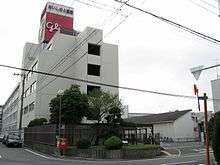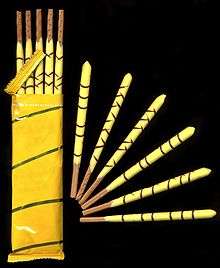Ezaki Glico
Ezaki Glico Co., Ltd. (江崎グリコ株式会社, Ezaki Guriko Kabushiki-gaisha) is a Japanese food company headquartered in Nishiyodogawa-ku, Osaka.[7] It does business across 30 countries, in North America, Asia-Pacific and Europe. [8]
 | |
Native name | 江崎グリコ株式会社 |
|---|---|
Romanized name | Ezaki Guriko Kabushiki-gaisha |
| Public KK | |
| Traded as | TYO: 2206 |
| ISIN | JP3161200005 |
| Industry | Food manufacturing |
| Founded | Nishi-ku, Osaka, Japan (11 February 1922)[1][2] |
| Founder | Riichi Ezaki (江崎 利一, Ezaki Riichi) |
| Headquarters | , |
Key people | Katsuhisa Ezaki (President and CEO)[1] |
| Products | confectioneries, ice cream products, processed food |
| Revenue | US$3,003,531 thousand (112.68 yen/US dollar, March 2016)[3] |
US$151,850 thousand (112.68 yen/US dollar, March 2016)[3] | |
US$127,478 thousand (112.68 yen/US dollar, March 2016)[3] | |
| Total assets | US$2,440,311 thousand (112.68 yen/US dollar, March 2016)[4] |
| Total equity | US$1,589,917 thousand (112.68 yen/US dollar, March 2016)[5] |
Number of employees | 4,961 (consolidated, March 2016)[6] |
| Subsidiaries | Glico Nutrition Co., Ltd. Icreo Co., Ltd. and others[7] |
| Website | glico.co.jp |

Overview
Ezaki Glico's primary business is manufacturing confectionery products such as chocolate, chips, chewing gums and ice cream, and dairy products. Additionally, Glico manufactures processed foods such as curry stocks and retort takikomi gohan pouch, and dietary supplement products.[9][10] Glico's main competitors are Meiji Seika, Lotte, Morinaga, Fujiya and Bourbon Company in confectionery business, and House Foods, Meiji and S&B Foods in processed food business.
Ezaki Glico's main financier was Sanwa Bank, which was merged into the Bank of Tokyo-Mitsubishi UFJ. Ezaki Glico is a member of Midori Kai, a group of companies whose main financier was Sanwa Bank.[11]
Corporate message
- "Good Taste and Good Health" (おいしさと健康, 1971—1992)
- "A Wholesome Life in the Best of Taste" (1992—, message in Japanese "おいしさと健康" is still in use)
History
Japan
In 1919, Riichi Ezaki created a caramel candy product containing glycogen extracted from oyster. The caramel candy product was named "Glico," a shortening of the word glycogen.[12] The sales copy of this product was "300 Meters in a Single Piece," and a running man was painted on the package.[13][14] On February 11, 1922 Riichi started selling Glico products at Mitsukoshi Osaka branch.
Later, in 1922, Riichi established a company, Ezaki Glico Co., Ltd.[15] Its Osaka Factory and Tokyo Factory were destroyed during World War II, and they were reopened in 1951.
In 1984, Glico Morinaga case, a series of criminal incidents targeting Japanese major food manufacturers, occurred. Ezaki Glico was one of the victims. Targeted by a group known as "The Monster with 21 Faces", the group claimed that $21 million ($2.26 billion Yen) worth of sweets were laced with Potassium cyanide soda, while Katsuhisa Ezaki, President and CEO, was kidnapped but escaped by himself. Ezaki Glico was blackmailed and its office was burned by the criminals.
Overseas
Ezaki Glico has been expanding its business overseas. At first, in 1932, Ezaki Glico established its factory in Dalian, China. In 1970, Ezaki Glico started its business in Thailand, establishing Thai Glico Co., Ltd. Later, in 1982, Generale Biscuit Glico France S.A. was established and started sales of Mikado (Pocky) in France. Ezaki Glico established Ezaki Glico USA Co., Ltd. in 2003. Additionally, it established PT Glico Wings (a joint venture with Wings Corp) in 2013 and PT Glico Indonesia in 2014, both of which are Indonesian companies.
Products
Ezaki Glico manufactures a wide variety of products. Just major products are listed here. [9][16]
Confectioneries

- TCHO, Berkeley, California based artisanal chocolate manufacturer of various chocolate bars.
- Glico, caramel product. In addition to the standard flavor, there are caramel flavor and crushed almond flavor products.[17]
- Pocky, chocolate-coated pretzel sticks, which come in many other flavors. [10] The total sales from 1966 exceeds 10 billion packages.[6] In Europe, this product is sold with the "Mikado" brand.[14]
- Pretz, pretzel sticks, which come in many other flavors.
- Almond Chocolate, almonds coated by chocolate.
- Caplico, frosting-dipped waffle biscuits in the shape of ice cream cones that come in either chocolate or strawberry flavor.
- Bisco, wheat germ crackers with yogurt cream using special yeast.
- BREO, an oral care candy that was developed for cleaning the tongue and breath.
Dairy products
- Pucchin Pudding, the world's best-selling pudding product. Its characteristic is a special package with which consumers can efficiently move the contents on a plate.
Ice-cream products
- Giant Cone, ice cream in a large cone with crisp chocolate and nut toppings.
- Panapp, vanilla ice cream in a handy long cup with fruit sauce fillings in the centre.
- Papico, sherbet that comes in tubes.
- Ice no Mi (アイスの実), bite-sized round ice candies. Ezaki Glico promoted this product by an extremely realistic CG character, Aimi Eguchi, who was created using facial features from members of the pop girl group, AKB48.[18]
- Calorie Control Ice Cream series, which uses lower-calorie sweetening agents maltitol and sucralose in place of sugar and starch syrup often used in ice cream. Tofu is also used to replace dairy products to lower the amount of calories.
Processed foods
- Ni-dan Juku Curry, cubed-type Japanese-style curry stock.
- Donburi-tei, instant donburi retort pouch product.
Baby formula
- ICREO Balance Milk, a powdered baby formula manufactured by Icreo Co., Ltd.
Advertisement
Ezaki Glico's large LED sign located above Dōtonbori in Osaka has been a landmark of the city since its initial construction in 1935. It bears the Glico running man on a blue race track, as well as some of Osaka's other landmarks in the background.[19] The giant neon sign has been revised on several occasions in order to celebrate events such as the World Cup and to bolster team spirit for Osaka's baseball team, the Hanshin Tigers. [20] As the sign is quite well known, it has long been a popular photo stop for tourists as well as locals.
Ezaki Glico was also the main sponsor of the anime series Tetsujin 28 (1963—1966, the original Japanese version of Gigantor).[21]
See also
- Aimi Eguchi, CGI pop idol created by Glico
- Pocky & Pretz Day, November 11 each year
- Glico Morinaga case
- Dōtonbori


References
- Ezaki Glico Co., Ltd. 2016, p. 51.
- The date when Riichi Ezaki started selling his first product "Glico" caramel. Ezaki Glico Co., Ltd. was established in February 1929, but it features February 11, 1922 as Glico group's "foundation date." Ezaki Glico Co., Ltd. 2017a, p. 55
- Ezaki Glico Co., Ltd. 2016, p. 12.
- Ezaki Glico Co., Ltd. 2016, p. 10.
- Ezaki Glico Co., Ltd. 2016, p. 11.
- Ezaki Glico Co., Ltd. 2017b.
- Ezaki Glico Co., Ltd. 2017a, p. 55.
- Ezaki Glico Co., Ltd. 2017c.
- Ezaki Glico Co., Ltd. 2017a, p. 37-42.
- Ezaki Glico Co., Ltd. 2017d.
- Midori Kai 2017.
- Ezaki Glico Co., Ltd. 2017e- Unless otherwise noted, the explanation in this "History" paragraph is based on this website.
- A piece of Glico is 15.4 kcal, which is enough energy to run exactly 300 meters. (Calculated from a formula stating that a person 165 centimeters in height and weighing 55 kilograms will burn 8.21 kcal running 160 metres in one minute. Over a period of 1.88 minutes, such a person would burn 15.4 kcal running 300 meters.)
- Ezaki Glico Co., Ltd. 2017a, p. 33.
- Ezaki Glico has been renamed several times. When established in 1929, the company name was Kabushiki-gaisha Ezaki. In 1934, it was renamed to Glico Kabushiki-gaisha and in 1943 ranamed to Ezaki Glico Co., Ltd. In 1949, the company name was changed to Glico Kabushiki-gaisha again and in 1958 it was renamed to the current name.
- Unless otherwise noted, the explanation in this "Products" paragraph is based on Ezaki Glico Co., Ltd. 2017a, p. 37-42.
- Ezaki Glico Co., Ltd. 2017f.
- Time 2011.
- The Japan Times 2015.
- Sankei West 2014.
- Allabout 2005.
Materials
- "Annual Report 2016" (PDF). Ezaki Glico Co., Ltd. 2016. Retrieved February 7, 2017.CS1 maint: ref=harv (link)
- "Company brochure" (PDF). Ezaki Glico Co., Ltd. 2017a. Retrieved February 7, 2017.CS1 maint: ref=harv (link)
- "Overview (Official Global Website)". Ezaki Glico Co., Ltd. 2017b. Retrieved February 7, 2017.CS1 maint: ref=harv (link)
- "Global Locations (Official Global Website)". Ezaki Glico Co., Ltd. 2017c. Retrieved February 7, 2017.CS1 maint: ref=harv (link)
- "Products (Official Global Website)". Ezaki Glico Co., Ltd. 2017d. Retrieved February 7, 2017.CS1 maint: ref=harv (link)
- "メンバー会社一覧". Midori Kai. 2017. Retrieved February 18, 2017.CS1 maint: ref=harv (link)
- "History (Official Global Website)". Ezaki Glico Co., Ltd. 2017e. Retrieved February 7, 2017.CS1 maint: ref=harv (link)
- "ガム・キャンディー". 江崎グリコ. 2017f. Retrieved February 7, 2017.CS1 maint: ref=harv (link)
- "Like iconic sign, confectionery giant Glico sets sights on overseas markets". The Japan Times. August 9, 2015. Retrieved February 7, 2017.CS1 maint: ref=harv (link)
- "W杯侍ジャパン、タイガース仕様…いろんな顔持つ5代目も"消灯"新たなシンボルに高まる期待". Sankei West. August 24, 2014. Retrieved February 7, 2017.CS1 maint: ref=harv (link)
- "石川尚のファニチャーワ−ルド的この店この逸品#03 鉄人28号(オマケ・極小の世界)". Allabout. April 2, 2005. Retrieved February 7, 2017.CS1 maint: ref=harv (link)
- "Japanese Scientists Build a Perfect (and Fake) Pop Star". Time. June 24, 2011. Retrieved February 7, 2017.CS1 maint: ref=harv (link)
External links
- (in English) Glico Global Official Site
- (in Japanese) Ezaki Glico Official website